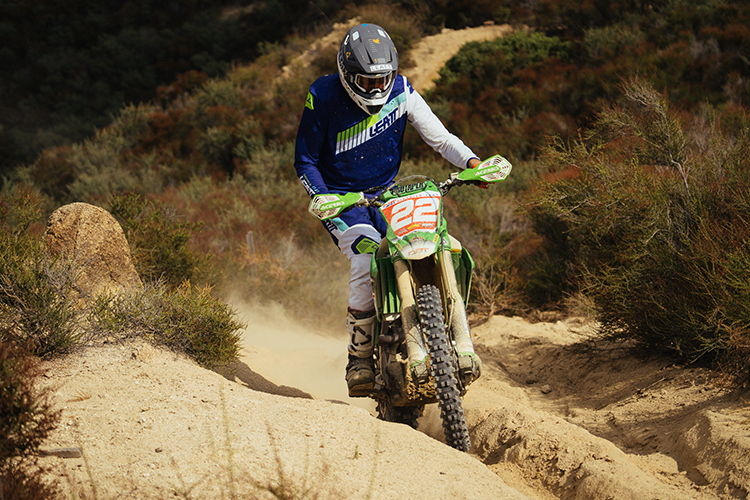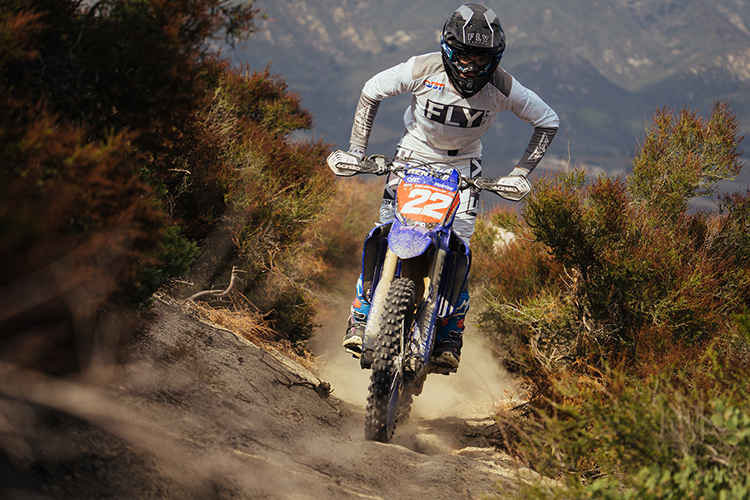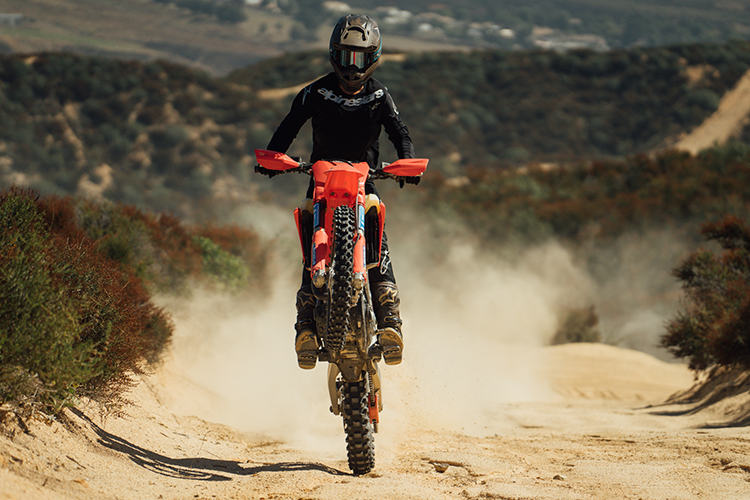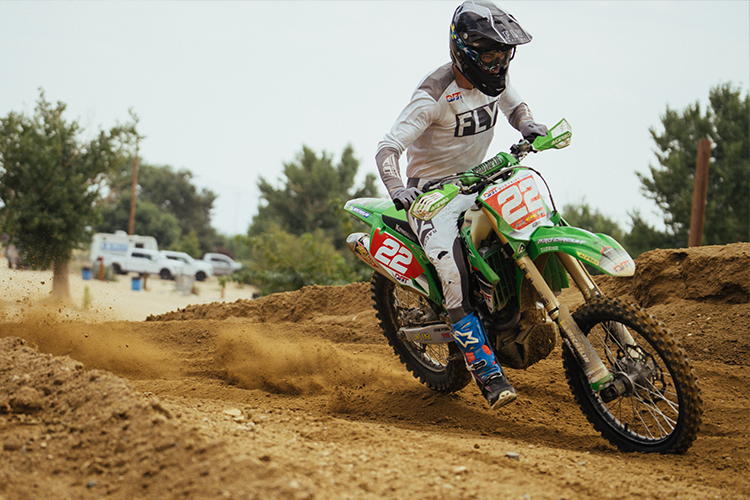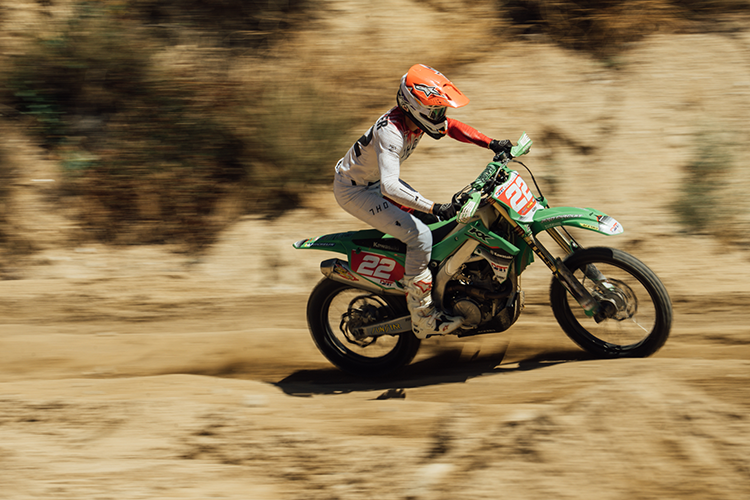Is Bigger Always Better?
Story by Trevor Hunter, Photos by Trevor Hunter, David Tenenbaum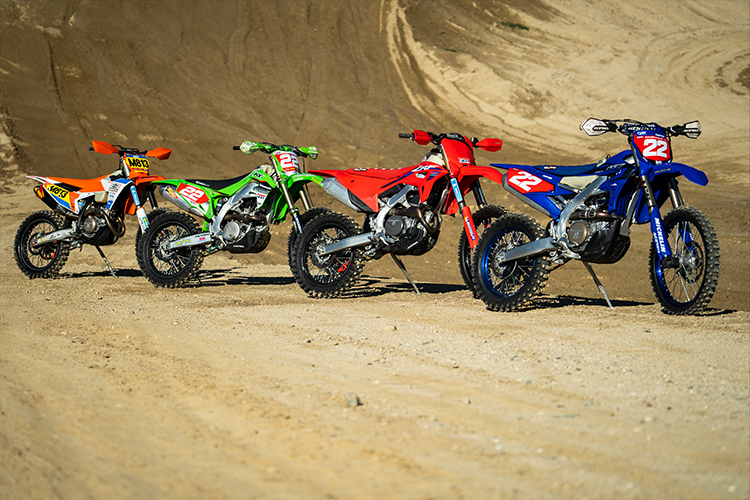
More often than not, media outlets (including ourselves) will conduct a “Shootout” amongst all of the major OEM’s bikes in a certain class. While they can be useful tools and describe the characteristics of the bikes at hand, very few riders and racers leave bikes completely stock. Common mods include suspension revalves, ECU tuning, exhausts, triple clamps, steering stabilizers, ergonomic changes, etc.
Knowing this, we set out to take the bikes from stock trim and modify them in the areas we felt they needed as West Coast Grand Prix race bikes. We felt it was important to set all of the bikes up for the same discipline/style of riding, and since Grand Prix racing is the most popular here on the West Coast, we went that direction. It’s not the most “off-road” style of riding or racing by any means, but it has the most ridership at the moment and with these bikes being so close to their MX counterparts, it’s truly what they are designed for in a lot of ways.
Some things to note about our testing. All of the bikes received suspension work from TCS Powersports. First, a test like this wouldn’t have been possible without the help of Todd at TCS. We’ve worked for over a year on setting all of these bikes up suspension wise and we felt it was important to use one tuner for all the bikes to make it a level playing field. Plus he was very active in riding all the bikes and feeling what test riders were commenting on.
Also, we outfitted every bike with Michelin StarCross 6 Tires. Each bike ran a 80/100-21 Medium/Soft Front Tire and 110/100-18 Medium/Hard Rear Tire. Tires are extremely critical to a bikes performance, so equipping them with the same tire combo keeps that at a level playing field as well. We’re big fans of the Michelin StarCross 6 Tires, and have liked a lot of their past tires as well so it was an easy decision to mount Michelin Tires on each test unit. They are less polar than many other choices for most of our riders.
As far as setup goes, myself (Trevor Hunter) was largely in charge of developing the KX450X and YZ450FX, while Todd Davis set up the KTM 450 XC-F and Todd/Trevor both had a hand in setting up the Honda CRF450RX. Keep this in mind as you read the individual rankings and how the different riders ranked each bike. Some bikes were more extensive than others which is something to take into account when seeing how these bikes stack up, but all were modified to a certain extent.
If you’d like to see how these bikes stacked up in stock trim, you can read our STOCK 2023 450 Off-Road Shootout HERE.
To checkout each rider’s individual opinion and ranking, click HERE.
To checkout each bike’s complete Bike Test, click through below:



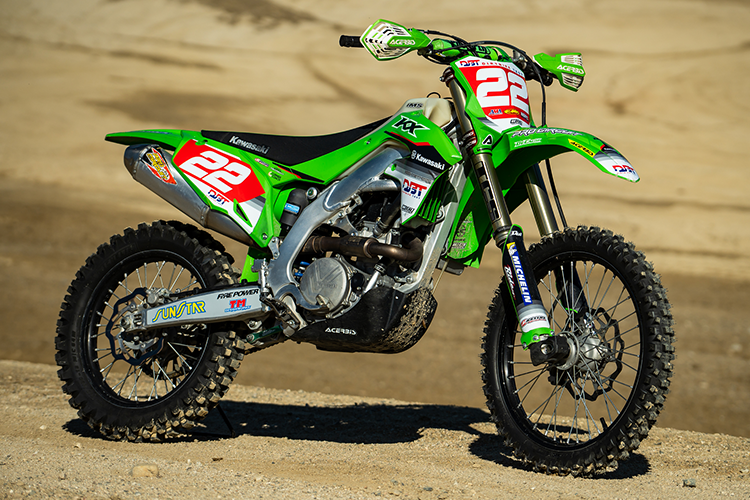
Rankings:
We really feel ranking bikes is the best method for you to decide anything (joking). Read, watch and learn as we describe the characteristics of each bike to see if the traits are ones that may be suited to you. There really is no bad bike, there’s just different bikes. However, everyone wants to see a winner and this is the only way we could determine how the bikes stand up when ranked by all of our riders. These are the scores that we came up with.
- Yamaha: 2+3+1+1+1+3+4+3 = 18
- KTM: 3+4+3+3+3+1+1+1 = 19
- Kawasaki: 4+1+2+2+2+4+3+4 = 21
- Honda: 1+2+4+4+4+2+2+2 = 21
Power
Yamaha: As it did in stock trim, the Yamaha motor was one of the more aggressive of the bunch, despite us taming it down with mapping and 14/52 gearing (13/50 is stock). The initial hit was smoothened out from stock, and the power was lengthened and more broad, but as the revs built up higher and higher, it would fall off. Still, the power plant packed a lot of torque and bottom end that liked to be ridden smoothly and short shifted.
One thing that commonly factored in how the Yamaha ranked is how the rider gelled with the Yamaha’s engine. Those who could trust the torque, ride in lower RPMs, and not be affected or distracted by a loud intake really liked the bike. Using the smooth power helped the chassis remain calm and overall had a large impact on how well received the Yamaha was. We feel if each rider had more time to adapt to the power, and more importantly find a map they like using the GYTR app that they really enjoy, this bike would’ve ranked higher for a few of the riders, particularly the less aggressive and older riders.
Additionally, it is important to note that this is the only bike that doesn’t have a close-ratio transmission. We played with gearing on all of the bikes, but there’s nothing we can do to compensate for having lower first and second gears and higher fourth and fifth gears on tap with no gearing changes needed to get there. Most riders liked this feature and took advantage of it in the varied conditions we rode the bike in.
KTM: The KTM engine was massaged into being the smoothest engine of the bunch hands down. It was set up with several mods to produce a mass amount of bottom end and torque, decent mid-range, and little on top. Simply put, it’s now built to be a “lazy” motor that can be lugged around in third and fourth gear, and never get in the same zip code as the rev limiter.
This motor was most appreciated by the vet riders as being very easy to ride and effective in all conditions, from motocross to single track. The Rekluse Radius CX Auto Clutch allowed the riders to really lug the bike around and the motor was slower to rev, making it easy to manage for longer durations of time. Likewise, the 13/50 gearing (13/52 is stock) helped lengthen each gear and spread out the motor in a smooth manner.
Honda: Similar to the KTM, the Honda was set up to be a smooth operator with most of its power coming down low. A lot of our riders liked the Honda engine in stock trim, so we kept it mostly stock. One issue we had with the CRF in stock trim is the engine is prone to stalling at slow speeds – a common trait when you ride a MX inspired bike in an off-road setting. The Rekluse Radius CX Auto Clutch allowed us to now ride the taller gears we like without abusing the clutch and constantly stalling the bike. Additionally, it eliminated a lot of engine braking which helped free up the chassis on decel and cornering.
Additionally, the 14/52 (13/50 is stock) gearing helped lengthen the power to not rev out so quickly and tame down the initial hit at the crack of the throttle. In faster speed areas, we don’t run out of gear nearly as fast as this was another area of concern when riding the bike all stock. Similar to the KTM, all of the vet and less aggressive riders really gelled with the CRF power plant and it was easy to ride in all conditions.
Kawasaki: The KX motor is easily the most aggressive of the group with a 350-esque power delivery style. The Kawi motor likes to be ridden hard and really shows its MX roots. The Precision Concepts ECU remap helped smoothen out the initial hit at low RPMs, and then lengthened the power to build progressively through the mid-range and into an uber impressive top end. While this worked well on a MX track, in faster off-road sections, and GP style terrain, it proved tough to ride in slow speed first-second gear singletrack. At slow speeds, the engine was on the verge of stalling and was upsetting the chassis a bit as it’d chug and jolt the bike forward just to keep the engine running. We feel playing with gearing (we ran 13/50 for this test and for our normal GP racing, with 13/51 being stock), adding a small flywheel weight, or even bolting on a Rekluse auto clutch would really help in this terrain if that’s what we were going to spend more time in.
Similar to the Yamaha, all of the younger, more aggressive riders appreciated this power, and nearly everyone felt that on a GP style track or in faster terrain, this is one of, if not the best motor in its class. However, it’s just more narrow focused than any of the other bikes.
Suspension
TCS Powersports has worked with us for the last year in developing settings on all four of these bikes. Some bikes have more development time than others simply due to they haven’t changed at all, but all have nearly the same work done to them. We had two separate test groups, one who were all 155-180 lbs and rode the bike sprung for ~165lbs, and another group of 200-225 lb riders who rode the bike sprung for ~210 lbs.
Yamaha: The Yamaha suspension was in the middle in terms of stiffness. It didn’t have the stiffest setup, but also not the softest setup. Of all the bikes, it’s the only one that didn’t get a single click touched by any of our eight test riders. We feel part of that is how well the TCS setting works, but also the KYB feel that a lot of our riders liked and felt comfortable with. The suppleness and initial plushness felt offers a lot of comfort and works well in the off-road terrain, but the hold up we were able to get out of it made it a very versatile setup that could be determined as the best suspension setup as a whole.
KTM: The KTM was equipped with the Technical Touch KYB Conversion Kit in the forks, paired with just a stock shock in the rear. We did have a set of re-valved AER48 forks on hand as well, and different riders preferred one set of forks more than others. The more aggressive riders gravitated towards the KYB forks, much in part due to the stiffer setting in it, while the less aggressive riders liked the softer, more compliant air forks more. Even though the KYB forks on the KTM have the exact same setting as the Yamaha, the KTM felt radically stiffer in every way, showing how much of an effect the chassis has on handling feel and not always in a good way.
Something we learned in testing was either going up a spring rate (from what we would typically run and what every other bike had) or adding air pressure to the forks helped this bike a lot. Because of the anti-squat characteristics of the new frame, it puts too much weight on the front end at all times and causes the front end to dive and ultimately ride lower in the stroke. Increasing spring rate helped balance the bike out and while it was something we struggled with in testing, no testers felt the bike was unbalanced with this setup.
Honda: Of all the bikes, the Honda setup was the softest overall. The slower the rider and/or the slower the terrain, the better the suspension worked. We felt erring on the side of caution and leaning on the side of being too soft on the Honda would help with some of what we struggled with the most – edge grip, deflection, harshness. Overall, this seemed to be the best way to go on the Honda as it worked well in areas we struggled with in stock trim – dry, square edge, high speed terrain.
Kawasaki: The KX450X Showa components were set up the stiffest of all the bikes and it showed. The more aggressive the rider, the faster the terrain, and the bigger the bumps, the better the bike handled. Every rider felt confident in charging as hard as they wanted to into anything, but in the true off-road terrain, it wasn’t quite as versatile which goes with the overall theme of the bike as a whole – it’s a bike that likes to be ridden aggressively and is better suited for fast terrain.
Handling
Yamaha: Despite it being the heaviest on the scale by a few pounds, most agreed the Yamaha felt to be one of, if not the lightest bike in the dirt again. The stability the Yamaha provides is unmatched and is the only bike we felt didn’t need a steering stabilizer. Likewise, the chassis comfort is as good as it gets and the rougher and worse the terrain got, the better it handled. Most riders really liked how well it performed in off-road terrain, but the advantages aren’t quite as apparent on a motocross or even some GP style tracks. Some riders struggled with cornering the bike, especially when riding the motor aggressively and in the higher RPMs, which the YZF isn’t the best cornering bike. Still, the Yamaha is the only bike with zero “chassis” modifications here – no triple clamps, stabilizer, engine mounts, etc. Every other bike received some amount of modifications to make it as forgiving as this chassis.
Everyone agreed the Yamaha cockpit was the most improved from stock with the GUTS Racing Tall Seat and the Fastway Footpegs in the lowered position. It opened it up to be almost “normal” in comparison to the rider triangle of other bikes. Some riders still felt unsure of the cockpit area, especially with the IMS Dry-Break tank and how that affects the seating area, but it’s something that wouldn’t be a factor if a regular screw cap is all that’s needed.
KTM:
The new gen KTM chassis is stiff and rigid. There’s no other way to put it; however, we made a lot of progress in relieving some of that rigidity with XTRIG 24mm Triple Clamps, FCP Engine Mounts, and chassis torque settings. Changing the offset from 22mm to 24mm was a huge step in the right direction to put less emphasis on the front end and get the bike to feel more balanced. Likewise, the FCP Engine Mounts took away some harshness and increased edge grip for when traction became a premium and bumps got squarer. Even with all these changes, the KTM chassis still felt the most rigid and ultimately held it back in riders’ rankings at the end of the day.
 Honda: The Honda still has the best cornering chassis of the group and really shines in tighter off-road trails. Even with the 23.5mm offset Ride Engineering Triple Clamps, the Honda responds well to direction changes and is a front end steering bike, though its stability and comfort is now much better than stock with the clamps. Even with the triple clamps, the bike is still sensitive to chassis changes and setup, and did require the most fine tuning from rider to rider. Furthermore, the rigid chassis feel is still there despite some modifications including triple clamps, torque settings, Flexx Handlebars, and more. We have plans to test some engine mounts soon as we feel this bike could benefit from some, but this chassis is simply just less forgiving than the Yamaha and Kawasaki – though not the least forgiving of the bunch.
Honda: The Honda still has the best cornering chassis of the group and really shines in tighter off-road trails. Even with the 23.5mm offset Ride Engineering Triple Clamps, the Honda responds well to direction changes and is a front end steering bike, though its stability and comfort is now much better than stock with the clamps. Even with the triple clamps, the bike is still sensitive to chassis changes and setup, and did require the most fine tuning from rider to rider. Furthermore, the rigid chassis feel is still there despite some modifications including triple clamps, torque settings, Flexx Handlebars, and more. We have plans to test some engine mounts soon as we feel this bike could benefit from some, but this chassis is simply just less forgiving than the Yamaha and Kawasaki – though not the least forgiving of the bunch.
The Flexx Handlebars on this bike were a big hit amongst nearly every test rider as it reduced some of the feedback to the riders hands and made the bike feel a little more forgiving. Interestingly, the Honda felt to be one of the heaviest feeling bikes of the bunch, though many liked how it performed in the tighter terrain which usually isn’t the case.
Kawasaki: The Kawasaki chassis is one of its highlights in how well it handles everything and appeals to a wide variety of riders. It’s not the most stable bike. It’s not the best cornering bike. Yet, it does both so well and riders who prefer one trait over another can usually find a happy medium in the handling department. Likewise, its bump absorption is more similar to the Yamaha than the other two in that it’s an overall comforting chassis that doesn’t feel overly rigid or require a lot of work to make it compliant. We started with XTRIG ROCS Triple Clamps but found those to be too rigid for our liking as an off-road bike, but the GPR upper triple clamp stiffened up the front end enough to be more precise and better cornering without adding any rigidity to the front end. Other than that, this KX chassis didn’t need much work and was a chassis favored by most every rider.
The ergonomics on this bike are the most universally praised and the only bike that didn’t get a “tall” seat, and really didn’t need one. While some of our testers would have still preferred it, it wasn’t as necessary on the other bikes – especially when the pegs are put in the lowered position.
Notable Highlights
Yamaha: As stated previously, it’s a bit astonishing at how little changes were made to the Yamaha in comparison to every other bike and how well it performed amongst the group. As is the case with any bike, but we feel especially with this bike, if we could spend some time with each rider beforehand in developing a map they like using the GYTR App, they’d be able to adapt to and gel with the bike better. A lot of the “negative” comments centered around the Yamaha engine, but as we quickly ran through some of our developed maps, the riders instantly liked the bike better. However, with limited time on a test day like this, we couldn’t fully get to a happy spot with every rider.
Additionally, the cockpit was still the least liked amongst all the riders and hurt its overall ranking – something there really isn’t much more that can be done to accommodate.
KTM: Every rider noted how rigid the KTM chassis felt, even with all these changes. That’s something that with all of the changes we made, has us wondering if the 450 XCF-W (PDS) could be a better starting point for most riders, including our own. It comes with cast triple clamps instead of billet (more flex in the cast clamps), a smoother power delivery, a wide-ratio transmission, and overall more compliant chassis. We’re hoping to get our hands on one of these bikes, build it up into a “GP race bike” similar to this XC-F we used, and see if the XCF-W version truly would be the better starting point and if it’d take less money/time to get to where we wanted.
Honda: The Michelin StarCross 6 Tires helped tremendously on this bike in particular. Riders who have spent a lot of time on this bike felt the edge grip was increased tenfold with these tires, and made a noticeable difference for the better. Likewise, the Honda motor was praised by many, including those who think they hate the Rekluse auto clutch. The stiffer natured chassis and sensitive setup points kept it from ranking higher than it did at the end of the day.
Kawasaki: The KX is the most “moto” bike here and liked to be ridden accordingly. The faster the terrain, the more the motor and chassis shined. If we were trying to set it up to be a more all-around off-road bike, we feel we could but it’d take more work/parts to do so. Because of its base, we feel it isn’t as versatile as say the Yamaha or KTM, but that doesn’t mean it’s not as competitive.
Michelin Tires: For a lot of these riders, this was their first ride on any Michelin tires and every rider praised the performance of the tires in the conditions we rode them in. Many felt they were stable under braking, had good edge grip, and found traction in areas where most other tires wouldn’t. Overall, we’re very pleased with the tires and felt they helped some of the bikes’ performance. We’ll have a full Product Test discussing these tires in further detail.
Conclusion
All of these bikes are good. The scores in this test were much closer (18, 19, 21, 21) than when we tested them in stock trim (13, 20, 20, 27) and had one tester flipped his order at all, the rankings could be completely different. This goes to show that all these bikes truly are good, and that personal preference makes up for the last 5% in how well a bike works for a rider when setup.
Individual Rider Opinions
Bio: Trevor Hunter
Ability: Off-Road Pro
Age: 24
Weight: 160lbs
Height: 5’7
Current Bikes: KX450X/YZ450FX/CRF450X
Ranking: YZ450FX, KX450X, 450 XC-F, CRF450RX
Bio: Brent Farrell
Ability: 50+ Off-Road Expert
Age: 53
Weight: 220lbs
Height: 6’6
Current Bikes: 2021 Husqvarna FX450
Ranking: 450 XC-F, KX450X, YZ450FX, CRF450RX
Bio: Todd Davis
Ability: 50+ Off-Road Expert
Age: 53
Weight: 210lbs
Height: 6’0
Current Bikes: 2023 KTM 450 XC-F
Ranking: 450 XC-F, CRF450RX, YZ450FX, KX450X
Bio: Jeff Belknap
Ability: 40+ Off-Road Expert
Age: 49
Weight: 190lbs
Height: 5’10
Current Bikes: 2023 Suzuki RM-Z250, 2009 CRF450X
Ranking: 450 XC-F, CRF450RX, YZ450FX, KX450X
Bio: Travis Nowak
Ability: Off-Road Intermediate
Age: 26
Weight: 180lbs
Height: 5’10
Current Bikes: KTM 250 SX-F
Ranking: CRF450RX, YZ450FX, 450 XC-F, KX450X
Bio: Tyler Belknap
Ability: Off-Road Pro
Age: 21
Weight: 165lbs
Height: 6’1
Current Bikes: 2022 YZ250FX
Ranking: YZ450FX, KX450X, 450 XC-F, CRF450RX
Bio: Gunnar Carlson
Ability: Off-Road Expert
Age: 21
Weight: 155lbs
Height: 5’10
Current Bikes: 2022 Husqvarna FX350
Ranking: YZ450FX, KX450X, 450 XC-F, CRF450RX
Bio: Robert Baehr
Ability: 50+ Off-Road Expert
Age: 56
Weight: 180lbs
Height: 5’11
Current Bikes: 2022 Husqvarna FC250
Ranking: KX450X, CRF450RX, YZ450FX, 450 XC-F
The best bike for you is here, you just have to assert your priorities and preferences to determine what bike that is, and if some of these modifications are what you want to do to your bike. At the end of the day, all four of these bikes are more than capable and there truly is no bad bike anymore.
